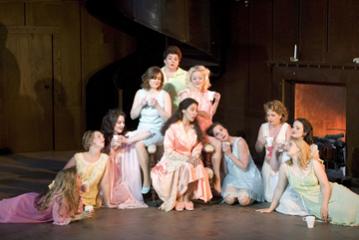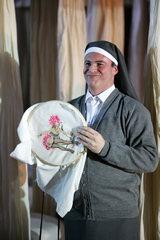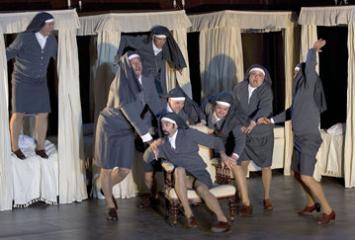Rossini, Le Comte Ory:
Garsington Opera, 25 June 2005 (H-T W)

On my journey from London to Garsington, I asked myself
why Garsington Opera came up with “Le Comte Ory” instead of
one of the endless, lesser-known operas by Rossini. After all,
it is not that long ago that Glyndebourne surprised us with
quite an exciting production, which had been revised in a later
season. But, suddenly I remembered an unforgettable “Cosi fan
tutte” directed by Peter Knapp at London’s Riverside Studio
some 25 years ago, which still outshines most productions I
have seen before or since. Furthermore, I remembered the well
known German proverb ‘Thinking one should leave to horses, because
they have bigger heads´, which finally put me in the mood to
look forward to the opera in Garsington, without any prejudice,
and knowing that at least David Parry, certainly the most inspired
Rossini conductor in this country, would bring this silly story
to life.

In the
first few bars of the overture the strings seemed a bit uneven,
but as soon as the opera took off it produced the most imaginative
entertainment, at the highest possible musical standards. Director
Robert Goold had the brilliant idea of mounting the action in
the garden of a contemporary rural French brasserie, which to
the left bordered on to the Chateau of the Countess Adèle (Juanita
Lascarro) and to the right on to the beautiful flower garden,
from where people entered the stage, thereby making the most
idyllic use of the back wall of the existing terrace and of
the Manor House. All the men in this community had disappeared
to fight a holy war – or may be, they were all shareholders
in any questionable British company. The women were left on
their own, longing for some kind of sexual entertainment, including
the Countess Adéle, her companion Ragonde (Anne-Marie Owens)
and her ladies-in-waiting. Rumour spread that a hermit had arrived,
who could solve all sorts of problems, and everybody was desperately
awaiting his arrival. Finally, on top of a high staircase in
the back the hermit (Colin Lee), the young disguised womaniser
Graf Ory, entered dressed as a Moonie priest covered in flowers
with a big hat, heavy dark sunglasses and a white stick miming
blindness.

He
offers his help and takes all the village girls with him. Meanwhile,
Le Gouverneur (Dean Robinson), Ory’s private tutor, and Isolier
(Victoria Simmonds), Ory’s page, are desperately trying to find
Count Ory, who has gone astray. Hearing of the Moonie priest
and his appetite for women, they know where to find Ory and
go off to look for reinforcement to catch him. The Moonie seems
to have done the job. All the girls come back happy, some even
still half dressed. He now helps the Countess by prescribing
her a love affair hoping he can fulfil his final goal. She accepts
his advice, but contrary to his desire admits her fondness for
Isolier. But when the tutor arrives, Ory’s cover is blown. Knowing
that the next day all the men will be back, he plans to stage
a fresh assault for the night.

The second act takes
place in the dormitory of Adéle’s ladies-in-waiting. Nine beds,
in constantly different positions, are the centre-piece. The
ladies, frightened by an enormous thunderstorm (one of Rossini’s
signature tunes), become hysterical when somebody knocks on
the door. Outside are `nuns´ fleeing the pursuit by Ory and
asking for shelter. They are welcome and soon the devil breaks
loose. Everybody seems to have found somebody to have fun with;
only Ory wanders through the dark dormitory in desperation for
Adéle, who protected by Isolier, manages to avoid him.
This
terzetto, one of the most delicate pieces of music Rossini ever
wrote, was the highlight of the entire performance. Rarely will
you find such beautifully light voices, with the singers’ Rossini
timbre matching each other in a way I have not experienced for
a long time. The Columbian soprano Juanita Lascarro, who ten
years ago made her British debut in the title role in Garsington’s
“Daphne”, the delicate mezzo Victoria Simmonds, who can easily
be taken for a boy and may soon be a great Octavian, and the
young South African tenor Colin Lee, harmonised with a perfection
and delicacy second to none – and not only as singers, but also
as fine and totally credible actors. Those three rare artists,
the unbelievable musical homogeneity of the chorus, even in
the most turbulent scenes, the simplicity of the design (Laura
Hopkins), the thoroughly and brilliant developed silliness of
this altogether silly story by Rupert Gould, the satirical movement
by Aletta Collins and last, but not least, David Parry as the
animated spiritus rector and convincing interpreter of Rossini’s
spirit – they all made for an unforgettable evening of full-blooded
and artistically superb music-theatre. I came to the conclusion
that, in this case, Glyndebourne could only be awarded silver,
while gold belonged to Garsington.
Hans-Theodor Wohlfahrt






